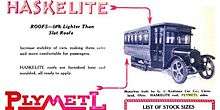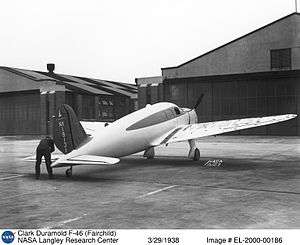Haskelite
Haskelite is the brand name of a plywood, once made by the Michigan-based Haskelite Manufacturing Corporation. It was made from waterproof glue developed by Henry L. Haskell. The moldable plywood was originally called Ser-O-Ply. It was used in the construction of various vehicles including military tanks, boats, airplanes, buses, trucks, and automobiles. The plywood was manufactured with different characteristics depending on particular needs and then given a brand name.

Background
Haskell invented a process for making glue from blood-albumin. The process used slaughterhouse blood from the Chicago stock yards.[1] The inexpensive waterproof adhesive was called "black albumin glue."[2] It was used to bond wood pieces.[3] One product Haskell made from this was a lightweight waterproof plywood, first known as Ser-O-Ply.[4] He applied this glue to wood veneers and manufactured plywood for various applications. Some of these applications were boats, airplanes, tanks, trucks, automobiles and rail cars.[4] The plywood panels were from 1/8th inch up to an inch thick and had various layers of crossed grain ply veneers to create the thickness and strength. Typical moldable plywood panels were about five feet wide by twenty feet long and 3/16th of an inch thick.[5] The plywood sheets made this way were eventually given the brand trade name of "Haskelite."[6] It is named after Henry L. Haskell, inventor of the glue bonding the plywood.[7]
Haskell formed a company for making plywood that ultimately became the Haskell Manufacturing Company in Ludington, Michigan and the Haskelite Manufacturing Corporation in Grand Rapids, Michigan. The glue was applied cold and spread onto wood veneers with rollers. A stack of three sheets of veneer was then put through a press, where each panel was subjected to a pressure of 150 psi between metal plates at 210 °F (99 °C).[6] This pressure and heat made the bond between the veneers permanent and the glue became insoluble.[3] The plywood was given brand names depending on its characteristics.[8] Plymetl had metal faces and was used in construction of airtight clothes vaults for storing furs and expensive garments.[9] Plymold was a plastic-based plywood that could be molded, and Phemaloid was a fire-resistant paneling.[10]
Boats
Thinner moldable plywood was used to make watercraft.[11] One model was the Haskell canoe. It was made from a type of plywood Haskell produced, consisting of veneers of birch on the outside and a redwood core. The unseamed canoe was made from a single piece of plywood; thousands were sold in the US. There were no ribs used in the building of the canoe.[3]
Airplanes

Haskel plywood was used for aircraft parts, especially fuselages and wings.[3] The first plane made with moldable plywood was constructed with Haskelite, and was the Curtiss two-place fighter Whistling Bill.[12] Haskell plywood was used for construction of experimental and commercial aircraft.[13] A Johnson Twin-60 experimental airplane was built in 1927 that had 85% Haskelite plywood in its wings, seats, instrument board, and fuselage parts.[14] The first successful commercial airplane it was used on was the 1937 Fairchild Aircraft model F-46.[15]
The Haskelite company was considered Ludington's most important industry during World War I.[16][17] The company made 5,000 military aircraft for the US and allies from 5,000,000 square feet of plywood produced. In 1927, the company manufactured aircraft body parts for Charles Linbergh's Spirit of St. Louis single engine plane. Haskelite's contributions during World War II were wooden aircraft body parts for US and ally airplanes. It made plywood parts for airplane trainers, gliders, bombers, and transports. Among these were plywood components for Britain's De Havilland Mosquito ("Wooden Wonder") fighter bombers. The manufacturing company also made wooden parts for Cessna Aircraft Company to use on their trainer airplanes.[18]
Duramold
A Haskelite specialty plywood designed for aircraft construction called Duramold was invented in 1939. The new plastic plywood consisted of thin veneers of wood and cloth that were impregnated with formaldehyde and phenol and sandwiched with a synthetic resin. Heat and pressure were used to bold the materials together. The specialty plywood was only about one-third as heavy as the aluminum alloys then used in manufacturing airplanes. National Bureau of Standards tests proved that for its weight it was stronger than metal. The plastic plywood was waterproof and could readily be formed into compound curvatures. Processes had been developed so that an entire fuselage could be turned out in two halves. They then were sealed together mechanically. Wing assemblies also were molded with this process.[19]
The General Bakelite Company and Haskelite Manufacturing joined the Clark Aircraft Company of Hagerstown, Maryland in manufacturing planes using duramold. Aeronautical engineer Virginius E. Clark designed the planes.[20] Aviator industrialist Howard Hughes helped finance the venture.[21] One of these airplanes had received a commercial license to fly daily and 500 hours of testing proved its worthiness. The fuselage was molded in 2 hours 35 minutes, which was 1/30th the time required to construct an ordinary fuselage. It was without longitudinal or cross bracing. The entire fuselage weighed less than 120 pounds. It did not have rivet, screw, or nail heads projecting into the air stream. The plane had a 450 horsepower motor, fixed landing gear, and accommodations for five persons. Its top speed was 235 miles per hour (378 km/h) and it cruised at 198 miles per hour (319 km/h). A typical airplane factory could manufacture parts of ten of these type planes a day. Then the specialty designed plywood wooden body parts could be assembled to complete the aircraft itself.[19]
References
- Smith 1930, p. 18.
- "Manufacturers:Haskell Boat Company". W C H A. Wooden Canoe Heritage Association. 2016. Retrieved May 12, 2016.
- Dunbar 1955, p. 439.
- Smith 1930, p. 19.
- Williams, Leonard P. (December 22, 1952). "Carrom Industries / Into Plywood Business (page 7)". Daily News. Ludington, Michigan – via Newspapers.com

- Motor_Body 1919, p. 54.
- Motor_Boat 1920, p. 38.
- Hardwood_Record 1920, p. 30.
- "Plymetl "Air-Tite" cloths vault". Chicago Tribune. Chicago, Illinois. November 9, 1923 – via Newspapers.com

- Marine_Engineering 1933, p. 208-213.
- "New Material Used in Boats". The News-Palladium. Benton Harbor, Michigan. June 24, 1939 – via Newspapers.com

- Kane, p. 70.
- "Haskelite, Hughes to Build Planes". Daily News. Ludington, Michigan. August 1, 1939 – via Newspapers.com

- "New Johnson Twin 60 adopts Haskelite". Aero-Digest. 10: 2. 1927. Retrieved May 12, 2016.
- "Ludington is Birthplace of Plywood Airplanes". Daily News. Ludington, Michigan. July 15, 1943 – via Newspapers.com

- "Local Company Contributed to war effort". Daily News. Ludington, Michigan. June 26, 1993 – via Newspapers.com

- "Carrom Company Is Diversified". Daily News. Ludington, Michigan. September 3, 1965 – via Newspapers.com

- Beld 2012, p. 99.
- "New Process Developed by Chicago Firm". Chicago Tribune. Chicago, Illinois. January 22, 1939 – via Newspapers.com

- "Speedy Production of Planes is Seen". The Miami News. Miami, Florida. July 9, 1939 – via Newspapers.com

- "Plastic Airplane Industry is near". Lansing State Journal. Lansing, Michigan. August 10, 1939 – via Newspapers.com

Sources
- Beld, Gordon G. (2012). The Early Days of Aviation in Grand Rapids. Charleston, South Carolina: Arcadia Publishing. ISBN 978-1614238058.CS1 maint: ref=harv (link)
- Dunbar, Willis Frederick (1955). Michigan Through the Centuries. Detroit, Michigan: Lewis Historical Publishing Company.CS1 maint: ref=harv (link)
- Hardwood_Record (1920). Hardwood Record. Chicago, Illinois: Hardwood Company.CS1 maint: ref=harv (link)
- Kane, Joseph Nathan. Famoue First Facts and Records. New York City: The H. W. Wilson Company.
The first airplane of molded plywood was the "Whistling Bill," a two-place fighter, built in 1918 by the Curtiss Aeroplane and Motor Company, Garden City, Long Island, N.Y. The fuselage was made of four 3/32nd-inch longitudinal sheets of Haskelite, three-ply birch plywood, steamed and formed to contour in a concrete die.
CS1 maint: ref=harv (link) - Marine_Engineering (1933). Marine Engineering. Simmons-Boardman Publishing Corporation.CS1 maint: ref=harv (link)
- Motor_Boat (1920). Motor Boat. Motor Boat Publishing Company.CS1 maint: ref=harv (link)
- Motor_Body (1919). Motor Body, Paint and Trim. Motor Boat Publishing Company.CS1 maint: ref=harv (link)
- Smith, S.H. (1930). Veneers and Plywood. S.H. Smith.CS1 maint: ref=harv (link)
External links
| Wikimedia Commons has media related to Haskelite. |